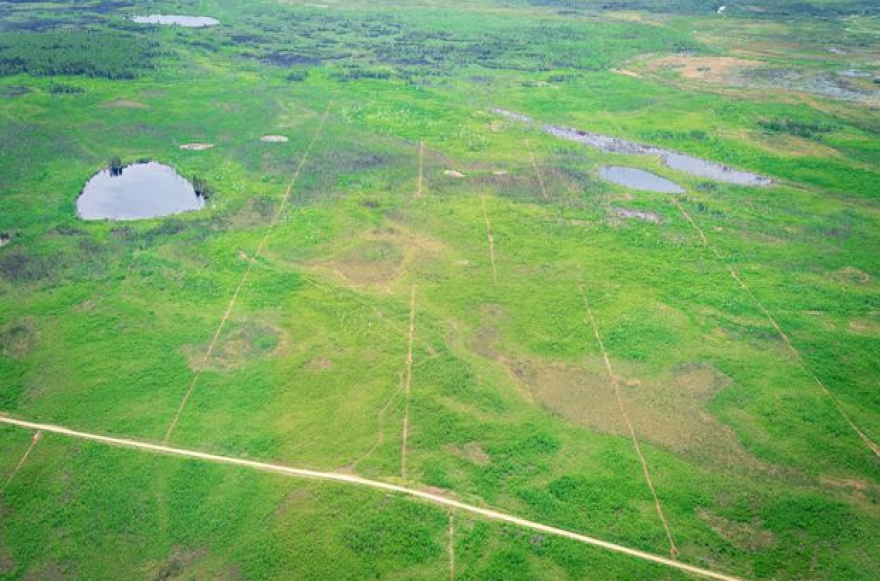But some area residents, tribal members urge state to reconsider development of 'industrial farming' project
The state is calling its first sale of potential farmland west of Nenana a success. The Department of Natural Resources, or DNR, auctioned more than 2,000 acres in the Nenana Totchaket Agricultural Project and is planning a second sale. But some area residents say the state is moving too quickly to develop the ag project.

DNR officials opened sealed bids Wednesday for the ag project parcels up for auction, and say they sold about 90 percent of the land offered.
“We typically sell 50 to 60 percent of what we offer,” says Rachel Longacre, a section chief with the department’s Division of Mining, Land and Water. She said in a Thursday interview with DNR officials that 2,045 acres were up for auction in parcels ranging from 20 to 320 acres.
“Our land sales typically have been smaller for agricultural areas,” she said. “This year was quite a bit larger.”
All but three of the 27 parcels drew bids, and those will be offered for over-the-counter sale next month. A DNR spokesperson says 18 parcels drew multiple bids, and seven got more than 10 bids each. The 15 apparent high-bidders for the land included 12 who listed an Alaska address; and they got four of the five biggest parcels.

That shows the auction was a success, says Tim Schilling, a natural resource manager with the department.
“We sold a lot of land,” he said Thursday. “There certainly seemed to be a lot of interest.”
But some Nenana-area residents and their allies see it differently. Lindsey Mailard is a Nenana tribal member whose family has deep roots in the area. She grew up in Fairbanks, and she and others are worried about the impacts of what they call “industrial farming” in the Totchaket.
“We’ve just been really disappointed with the poor management and engagement with the tribal community,” she said Thursday.
Mailard works for Native Movement, an Alaska-based nonprofit that advocates for indigenous peoples. The organization, which has called for a pause in the state's plans for the ag project, was the highest bidder on two parcels, and she says members intend to develop them in a way that protects the land from erosion and preserves it for traditional uses like hunting and trapping.

“I’m excited and happy about that,” she said, “because that means that we can ensure that it is managed with indigenous stewardship.”
Mailard and other area residents say the state’s plan to develop the ag project won’t create food security, as state officials insist, but instead will harm the land.
“The state has not been taking the time to really listen to the concerns that the community has and that the tribe has,” she said. “The engagement has been really poor.”
DNR’s Longacre disagrees.
“We have addressed anyone who’s reached out to us in an official capacity,” she said.
Longacre says the state has complied with all the required public notices and scoping meetings in the lead-up to the auction and has communicated with area residents since it began last summer. Other supporters of the process point out that the state has been planning to develop the ag project since the 1970s.
The process includes requiring all the auction successful bidders must have an approved conservation plan completed by the spring, before they can begin working the land. State Agriculture Division natural resources specialist Erik Johnson says he expects most of the new landowners will be clearing land next summer after the state OKs their plans. He says some may then begin working the land to prepare it for planting.

“Row crops or orchards … those are probably going to take a year to get the land cleared and prepped for planting,” he said Thursday.
He said some livestock could be brought in to the ag project as early as next summer.
“If they have animals, they might possibly put them out, as soon as they have fencing.”
Johnson says goats or reindeer could take to the land quickly, because they browse on natural vegetation, like shrubs. He reckons it would take at least another season to prepare and plant on land intended to be used for cattle or horses, which require grass to graze.
“I think that they can start getting crops in the ground the second year,” he said. “So, September of 2024 is likely when they will be harvesting those row crops.”
DNR officials say that’s about when they hope to conduct the second ag project land auction.
Editor's note: This story has been revised to clarify that Lindsey Mailard grew up in Fairbanks. She has family ties to Nenana and spent the past two summers there working with culture camps and food sovereignty advocacy.



